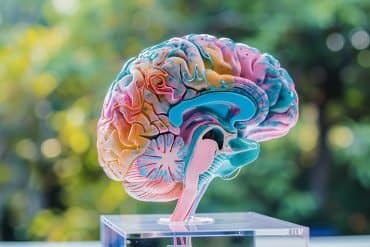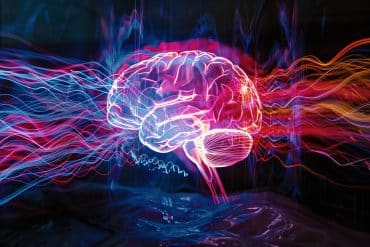Summary: Brain connections strengthened with treatment from fast-acting antidepressants, such as ketamine, are consolidated during deep sleep. Researchers propose rapid antidepressant treatments share the ability to regulate both synaptic potentiation and homeostatic mechanisms, which may contribute to how the brain reorganizes its activity to defeat depression.
Source: University of Helsinki
Ketamine alleviates depressive symptoms within hours, with the most significant change typically seen a day after its administration. However, the symptoms often reappear within a week. According to researchers at the University of Helsinki, neural connections strengthened by the quick treatment of depression are consolidated in the brain during the deep sleep periods of the following night. To prevent the circle of negative thoughts regaining supremacy, depressed patients also need therapy.
Depression and long-term stress have been demonstrated to cause changes in the brain which offer a partial explanation for depressive moods, apathy, memory difficulties and other symptoms commonly associated with depression. Unbroken circles of negative thoughts are also often a distinct aspect of the mental status of depressed patients. This is down to very active and selective brain function.
“In turn, this strengthens the neural connections associated with precisely this type of thinking. Less active connections and neural networks supporting normal brain function weaken due to a lack of use, which completes the circle of negativity. The result is an imbalance of activity among neural networks, and clinical depression,” says Associate Professor Tomi Rantamäki from the Faculty of Pharmacy, University of Helsinki.
The vicious circle could be broken by guiding the brain back towards a more comprehensive mode of action. Such guidance can be boosted by means of psychotherapy, but the effects manifest slowly. In recent years, rapid-acting modes of treatment for depression have been investigated, potentially offering entirely novel approaches. The latest new product is a nasal spray that contains esketamine, which was just granted a marketing authorisation in Europe.
“What ketamine, psychiatric electroconvulsive therapy, nitrous oxide and certain other therapies already in use or currently being trialed have in common is the fact that they increase the activity of broad cortical areas and strengthen synaptic connections. At their best, they force the broad neural networks of the cerebral cortex into an entirely new kind of interaction, which makes it possible to weaken the previous imbalance,” notes Samuel Kohtala, a postdoctoral researcher at the University of Helsinki.
However, such rapid relief is only temporary, unless the plasticity mechanisms endogenous to the nervous system are utilised.
“According to the synaptic homeostasis hypothesis, synapses strengthened during the day undergo a process of renormalisation in deep sleep, which is dominated by slow-wave activity. The most potentiated synapses may retain their relative strength better than weaker synapses, which presents an opportunity for learning new information while purging the network of excessive noise. We think that rapid antidepressant treatments share the ability to regulate both synaptic potentiation and the reciprocal homeostatic mechanisms, which weaken synaptic strength during sleep. Either of these mechanisms can contribute to how the brain can reorganise its activity to defeat depression,” Kohtala says.

Based on the studies, molecular mechanisms implicated in neuronal plasticity are particularly activated during periods of slow-wave activity. Thus, slow-wave responses could be a useful measure for determining treatment efficacy and developing novel treatments.
The researchers point out that, boosted by similar mechanisms, brain function may again be derailed during subsequent sleep periods, unless the neural networks driving the depression are sufficiently controlled, for example, by means of psychotherapy.
“The main symptoms of depression can be artificially affected by destabilising the functioning of neural networks. A more permanent effect requires tackling the root causes of the problem as well,” Rantamäki emphasises.
About this depression research article
Source:
University of Helsinki
Media Contacts:
Tomi Rantamäki – University of Helsinki
Image Source:
The image is in the public domain.
Original Research: Open access
“Encoding, Consolidation, and Renormalization in Depression: Synaptic Homeostasis, Plasticity, and Sleep Integrate Rapid Antidepressant Effects”. by Tomi Rantamäki and Samuel Kohtala.
Pharmacological Reviews doi:10.1124/pr.119.018697
Abstract
Encoding, Consolidation, and Renormalization in Depression: Synaptic Homeostasis, Plasticity, and Sleep Integrate Rapid Antidepressant Effects
Recent studies have strived to find an association between rapid antidepressant effects and a specific subset of pharmacological targets and molecular pathways. Here, we propose a broader hypothesis of encoding, consolidation, and renormalization in depression (ENCORE-D), which suggests that, fundamentally, rapid and sustained antidepressant effects rely on intrinsic homeostatic mechanisms evoked as a response to the acute pharmacological or physiologic effects triggered by the treatment. We review evidence that supports the notion that various treatments with a rapid onset of action, such as ketamine, electroconvulsive therapy, and sleep deprivation, share the ability to acutely excite cortical networks, which increases synaptic potentiation, alters patterns of functional connectivity, and ameliorates depressive symptoms. We proceed to examine how the initial effects are short-lived and, as such, require both consolidation during wake and maintenance throughout sleep to remain sustained. Here, we incorporate elements from the synaptic homeostasis hypothesis and theorize that the fundamental mechanisms of synaptic plasticity and sleep, particularly the homeostatic emergence of slow-wave electroencephalogram activity and the renormalization of synaptic strength, are at the center of sustained antidepressant effects. We conclude by discussing the various implications of the ENCORE-D hypothesis and offer several considerations for future experimental and clinical research.
Significance Statement
Proposed molecular perspectives of rapid antidepressant effects fail to appreciate the temporal distribution of the effects of ketamine on cortical excitation and plasticity as well as the prolonged influence on depressive symptoms. The encoding, consolidation, and renormalization in depression hypothesis proposes that the lasting clinical effects can be best explained by adaptive functional and structural alterations in neural circuitries set in motion in response to the acute pharmacological effects of ketamine (i.e., changes evoked during the engagement of receptor targets such as N-methyl-D-aspartate receptors) or other putative rapid-acting antidepressants. The present hypothesis opens a completely new avenue for conceptualizing and targeting brain mechanisms that are important for antidepressant effects wherein sleep and synaptic homeostasis are at the center stage.
Feel Free To Share This Psychology News.






